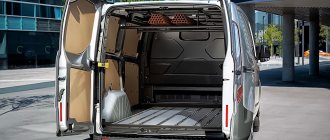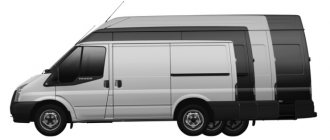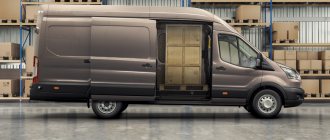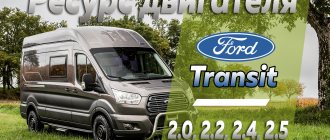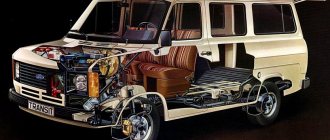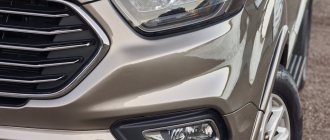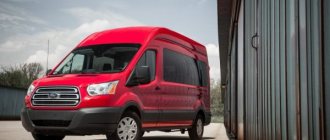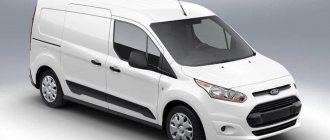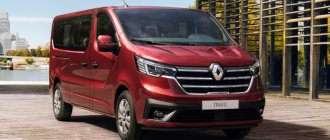Deja vu on all roads of the country
Andrey Filippov, photo by the author
| Manufacturer: | Ford Sollers Holding LLC (Elabuga) |
| Model: | Ford Transit V363 VAN (L3H3) |
| Start of sales in Russia: | 2014 |
| Price: | basic configuration - 1,800,000 rubles. |
Yes, it's the blue Ford Transit van again. What made me return to testing the machine, an analogue of which we tested in the fall of 2015, was such a banal fact as... statistics. At the end of the first quarter of 2017, Transit sales increased by 55%, and the total number of all cars sold, including bodybuilder conversions, reached 1,418 units! Perhaps, by the standards of a Russian bestseller, the figure is not so large, but among fellow competitors with imported roots this is already a very respectable figure.
According to the Association of European Businesses (AEB), at the end of 2016, the new generation Ford Transit took a leading position in the LCV class among models of foreign brands in Russia. Its share in the segment amounted to 22.4% of the sales volume of foreign brands, which corresponds to an increase of 9% and is the best LCV indicator. Last year, 5,562 (+30%) vehicles based on the Ford Transit were sold - this is the best figure among all Ford models presented in Russia.
Cabin - home
“Leader of Sales” does not visually boast of its newfound status. It's still the same van that we tested two years ago - except that the roof is higher and the wheelbase is longer. For a journalistic test drive, this means more windage, increased fuel consumption and worse maneuverability in yards. Moreover, the price tag for washing (“wow, how big”) will be one and a half times higher. For real use, such an increase means a noticeably larger body capacity with almost the same occupied space on the road, so to each his own...
In connection with the above, today there will be the shortest description of the cabin - the driver’s workplace is completely identical to that of the Ford Transit from my previous test drive. And I noted all the important nuances of the layout that are worth mentioning in the photographs.
With a van it's a little different. Firstly, the high roof has brought back into place a convenient shelf above the cabin with access from the cargo compartment, the absence of which I complained about last time. Secondly, this time the car was in a simpler modification, without plywood on the sides, which made it possible to study the internal structure of the van’s walls. I will say this, if you are transporting a relatively light, multi-format groupage cargo, it is better to take a car without casing - this will give you at least fifty technological holes that allow you to personally secure almost every box. Of the minuses, along with the plywood, the 12-volt socket on the right rear pillar, which was so pleasing in the last test, also disappeared.
Otherwise, the same roomy hangar with a plastic floor, a huge sliding door on the starboard side and a “gate” that swings open 270° in the stern - Ford Transit at its best.
To get inside, you will have to grab hold of the available parts - a handle, alas, is not provided. But the rear bumper-step deserves an “excellent” rating - a size 42 boot fits 2/3 on it
Less is better
The new diesel 2.0 EcoBlue features a cast iron block, an aluminum head, a variable displacement turbocharger, a common rail fuel rail (injection pressure 2000 bar) and piezoelectric injectors. Compression ratio - 16.5. Power - 105, 130 or 170 hp. In Europe, engines are strangled for Euro-6, but for our market they will be “released” to Euro-5, abandoning the neutralizer with urea injection. It wouldn’t hurt to also reduce the vibration level: the tremor on the steering wheel and pedals is intrusive, especially at idle.
The rear doors swing open to an angle of up to 180°. There is one side sliding door - on the starboard side. For an additional fee, you can order the same one on the left side (before restyling they charged 40,000 rubles for this). Cargo capabilities remain the same. There are two wheelbase options (2933 and 3300 mm), two body lengths (4973 and 5340 mm) and two height options (2000 and 2343 mm unladen). The volume of the cargo compartment is from 6 to 8.3 m³, the payload is from 765 to 1450 kg. The floor is covered with non-slip and wear-resistant plastic. The walls can be covered with plywood.
The rear doors swing open to an angle of up to 180°. There is one side sliding door - on the starboard side. For an additional fee, you can order the same one on the left side (before restyling they charged 40,000 rubles for this). Cargo capabilities remain the same. There are two wheelbase options (2933 and 3300 mm), two body lengths (4973 and 5340 mm) and two height options (2000 and 2343 mm unladen). The volume of the cargo compartment is from 6 to 8.3 m³, the payload is from 765 to 1450 kg. The floor is covered with non-slip and wear-resistant plastic. The walls can be covered with plywood.
Winter - Russian reality
During the test, I clocked up 4,369 km on the Ford Transit odometer. Not much for a deep analysis, but enough to form a definite opinion about the car.
The first and, perhaps, one of the most striking impressions of driving a van is the excellent smoothness of the ride. It’s one thing when you change to a Ford from a classmate, then the contrast is clear, different settings, different priorities. But I advise you to be careful when transferring from a Transit to a minivan or SUV; for a long time I could not believe that an empty van could be so much nicer than cars for transporting passengers. Perhaps, when maneuvering at speeds of 140 km/h, I would have understood what the “disadvantages” of such a suspension were, but the speed range of commercial light-duty vehicles lies in the range of 90–110 km/h, and there the test subject’s handling was fine. So thanks to those who designed the suspension - they did an excellent job.
The second pleasant moment was the operation of the pre-heater with remote control. Being directly in the apartment, you press the button and after 15 minutes you sit down in a warm interior and start the engine, warmed up to... 80 °C! A very useful addition, I advise everyone not to skimp.
There's not much to say about the test drive itself. Despite the fact that I tested the car both in snowfall and in February rain, I cannot note any interesting nuances. Ford Transit in any weather turns out to be a banal hard worker, whose goal is not to surprise the driver, but to cause him as little trouble as possible, and in this context it is impeccable. The only thing, like most of its colleagues, Transit is dirty, and when driving on a wet highway, the side windows very quickly become covered with a coating, through which only the outlines of cars are visible in the mirrors. This fact is especially annoying at night, when every 150–200 km you have to stop and wipe the windows, otherwise the lenses only show a light spot from a car coming behind, from which it is impossible not only to determine the distance, but even to understand whether it is a truck or a car.
I traditionally show fuel consumption in the table.
As you can see, it is not very different from that of the short wheelbase from the last test. Fuel consumption of a Ford Transit VAN (according to the on-board computer)
| Driving mode | Desired speed, km/h | Real speed, km/h | Fuel consumption, l/100 km |
| Route | 80 110 130 | 81 86–102 114–120 | 7,7 8,5–10,8 10,9–12,3 |
| City | 80 (Moscow) | 28 | 10,4 |
| Mixed mode | – | 57–67 | 9,3–8,5 |
Dependence of speed on engine speed Ford Transit VAN (according to instrument data)
| Speed, km/h | 70 | 80 | 90 | 100 | 110 | 120 | 130 |
Engine speed, min-1:
| 1150 1400 | 1300 1600 | 1450 1800 | 1600 2000 | 1750 2200 | 1900 2400 | 2050 2600 |
However, the table is always a striving for ideal. In real life, when driving along the highway at a speed of 90 km/h, and stopping for a 3-hour nap with the engine running, the consumption was 8.5 l/100 km at an average speed of 60 km/h. At the same time, when driving around the city, but without traffic jams at an average speed of 29 km/h, the consumption does not exceed 8.6 l/100 km.
We were definitely and unconditionally pleased with the NOKIAN Hakkapeliitta C3 235/65 R16C tires. Not only do they steadily hold the road covered with a 2-centimeter layer of snow porridge, they also forgive minor mistakes when entering a turn at a deliberately high speed - you manage to understand from the body roll that you have overdone it, and slow down before it starts slip. But the fun begins in snowy yards or unplowed driveways. Where classmates timidly try to stay on the cleared part when driving away, you can safely “dip” the wheel into a snowdrift. “Gas to the floor” and the Transit literally bites into the snow, clinging to twigs, grass, ground - in a word, to everything that can provide support and allow one to push off. The other side of the coin is that if you miss the turning point, the van will instantly land you on its belly, even despite the relatively high ground clearance.
And one more thing - good traction can play a cruel joke on you when maneuvering in reverse. The combination of a powerful engine and grippy tires tempts you to push through the snowdrift a little in order to turn around “in one sitting,” but why, it’s moving?! But in this case, the beam of the rear portal axle turns into a bulldozer, which, most likely, will push through loose snow and cut off the ice parapet without problems. Just look at the photo - will the tubes and hoses withstand such treatment?..
Key and screwdriver
Like all modern cars, the Ford Transit does not like interference in its bowels. No, a hefty Talmud with technical descriptions of the assembly and disassembly of ceiling lamps, lanterns, etc. There are still some things left, so they will trust you to replace the light bulb, but there is no longer any need to do anything more serious - there is a direct road to service. I won’t force my opinion on anyone, but for me it’s correct.
However, let me remind you that no matter how rosy the branded service may seem, no one removed the obligation to carry out ETO from the driver. Oil dipstick, containers for technical fluids - everything is available for both visual inspection and replenishment. Since the Transit battery is hidden under the driver’s seat, a terminal is located under the hood for “lighting”, covered with a characteristic red cover next to the fuse box - it is impossible to confuse it in principle. Everything is as it should be with a modern LCV.
And the only characteristic moment - unlocking the hood with the ignition key from the outside will surprise only those who have not previously dealt with this signature Transit feature. By the way, it has been verified: even when a dense shell of snow porridge covers the entire “face” of the van, the lock cylinder, covered with an elastic band with a slot, remains clean.
According to the mind
All cars are equipped with a start-stop system.
All cars are equipped with a start-stop system.
Transit Custom was previously generously equipped with electronic assistants, and now it is literally packed with them. I was interested in the Intelligent Speed Assist speed control system, which recognizes road signs and maintains the permitted speed. A good idea, but I was never able to get the car to slow down on its own, although it read the signs accurately, albeit sometimes with a delay. And this is on German roads, where the signs are not hidden behind trees and are not installed anyhow. What will it be like in Russia?
But the Pre-Collision Assist automatic braking system works without any whims. Tested: Ford brakes independently in front of obstacles.
In the city, life is made easier by the Cross Traffic Alert system, which, when reversing, informs about the approach of cars, cyclists and pedestrians. The car also warns about leaving the lane, about driver fatigue, and switches the lights from high to low - it’s as smart as a thoroughbred passenger car!
Ford Transit Custom
Ford Transit Custom
No room for error
So, the test drive is completed. Was it useful - no doubt, did it open up new facets, of course, but overall...
Ford Transit is good. It was like this when it debuted on our market and remains like this now. A balanced car with a well-thought-out interior undoubtedly outperforms its competitors in the eyes of drivers. An economical and high-torque engine, a well-chosen gearbox, clear and predictable control - the list of its “advantages” could take a long time. But the pressing question remains: “Will the difference in quality and image of the Ford brand be able to outweigh the difference in cost with the main Russian player in the market?”
According to the parking sensors, it’s time to stop, but the crossover is not visible in the mirror at all
And for my part, with a clear conscience I can recommend Ford Transit as a business partner - the main thing is to realize that the more modern the car, the more careful care it requires. Don't skimp on this and Ford won't let you down.
Provided a car for testing
Technical characteristics of the Ford Transit V363 VAN (L3H3)
| Parameter | Meaning |
| Total weight, kg | 3500 |
| Curb weight, kg | 2044 |
| Load capacity, kg | 1454 |
| Cargo compartment capacity, m3 | 13 |
| Permissible load on 1st/2nd axles, kg | 1750/2250 |
Engine:
| GLOBAL PUMA 2.2 Turbodiesel, I-4 2198 125 at 3500 min-1 350 at 2000 min-1 |
Transmission:
| VMT-6 Mechanical 6/1 |
| Suspension | Front – independent, MacPherson type, with spiral springs of variable stiffness, shock absorbers and stabilizer Rear – dependent, leaf spring with shock absorbers |
| Brake system | Double-circuit, with disc brakes |
| Wheel formula (drive type) | 4x2 (front) |
| Minimum turning radius, m | 12 |
| Fuel tank capacity, l | 80 |
